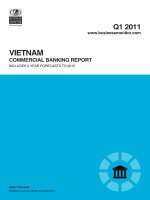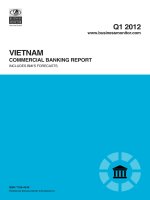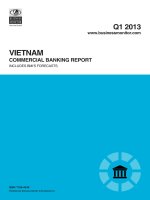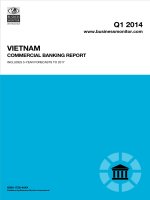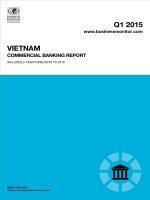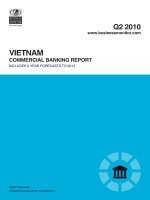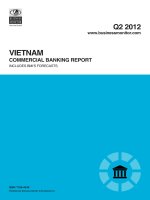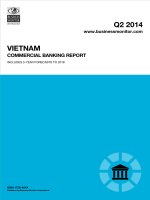Vietnam commercial banking report q1 2015
Bạn đang xem bản rút gọn của tài liệu. Xem và tải ngay bản đầy đủ của tài liệu tại đây (515 KB, 78 trang )
Q1 2015
www.businessmonitor.com
VIETNAM
COMMERCIAL BANKING REPORT
INCLUDES 5-YEAR FORECASTS TO 2018
ISSN 1758-454X
Published by:Business Monitor International
Vietnam Commercial Banking
Report Q1 2015
INCLUDES 5-YEAR FORECASTS TO 2018
Part of BMI’s Industry Report & Forecasts Series
Published by: Business Monitor International
Copy deadline: November 2014
Business Monitor International
Senator House
85 Queen Victoria Street
London
EC4V 4AB
United Kingdom
Tel: +44 (0) 20 7248 0468
Fax: +44 (0) 20 7248 0467
Email:
Web:
© 2014 Business Monitor International
All rights reserved.
All information contained in this publication is
copyrighted in the name of Business Monitor
International, and as such no part of this
publication may be reproduced, repackaged,
redistributed, resold in whole or in any part, or used
in any form or by any means graphic, electronic or
mechanical, including photocopying, recording,
taping, or by information storage or retrieval, or by
any other means, without the express written consent
of the publisher.
DISCLAIMER
All information contained in this publication has been researched and compiled from sources believed to be accurate and reliable at the time of
publishing. However, in view of the natural scope for human and/or mechanical error, either at source or during production, Business Monitor
International accepts no liability whatsoever for any loss or damage resulting from errors, inaccuracies or omissions affecting any part of the
publication. All information is provided without warranty, and Business Monitor International makes no representation of warranty of any kind as
to the accuracy or completeness of any information hereto contained.
CONTENTS
BMI Industry View 7
Table: Commercial Banking Sector Indicators 7
Table: Commercial Banking Sector Key Ratios, October 2013 7
Table: Annual Growth Rate Projections 2013-2018 (%) 7
Table: Ranking Out Of 73 Countries Reviewed In 2014 8
Table: Commercial Banking Sector Indicators, 2011-2018 8
SWOT 9
Commercial Banking 9
Political 10
Economic 11
Business Environment 13
Industry Forecast 14
Industry Risk Reward Ratings 17
Asia Commercial Banking Risk/Reward Index 17
Table: Asia Commercial Banking Risk/Reward Index 18
Market Overview 19
Asia Commercial Banking Outlook 19
Table: Banks' Bond Portfolios, 2013 19
Table: Comparison of Loan/Deposit & Loan/Asset & Loan/GDP ratios, 2014 19
Table: Comparison of Total Assets & Client Loans & Client Deposits (USDbn) 20
Table: Comparison of USD Per Capita Deposits, 2014 21
Economic Analysis 22
Table: Economic Activity (Vietnam 2009-2018) 28
Competitive Landscape 29
Market Structure 29
Protagonists 29
Table: Protagonists In Vietnam's Commercial Banking Sector 29
Definition Of The Commercial Banking Universe 29
List Of Banks 30
Table: Financial Institutions In Vietnam 30
Company Profile 32
Agribank 32
Table: Balance Sheet (VNDmn) 34
Table: Balance Sheet (USDmn) 34
Table: Key Ratios (%) 35
Bank for Foreign Trade of Vietnam (Vietcombank) 36
Table: Stock Market Indicator 38
Table: Balance Sheet (VNDmn) 38
Vietnam Commercial Banking Report Q1 2015
© Business Monitor International Page 4
Table: Balance Sheet (USDmn) 39
Table: Key Ratios (%) 39
Eximbank 40
Table: Stock Market Indicators 42
Table: Balance Sheet (VNDmn) 42
Table: Balance Sheet (USDmn) 43
Table: Key Ratios (%) 43
Sacombank 44
Table: Stock Market Indicators 46
Table: Balance Sheet (VNDmn) 46
Table: Balance Sheet (USDmn) 46
Table: Key Ratios (%) 47
VietinBank 48
Table: Stock Market Indicators 50
Table: Balance Sheet (VNDmn) 50
Table: Balance Sheet (USDmn) 51
Table: Key Ratios (%) 51
Regional Overview 52
Asia Overview 52
Political Concerns To Weigh? 57
Virtuous Cycle For Economic Growth 58
Global Industry Overview 59
Global Commercial Banking Outlook 59
Financial Sector Reform A Key Factor In Loan Growth 64
Demographic Forecast 68
Table: Population Headline Indicators (Vietnam 1990-2025) 69
Table: Key Population Ratios (Vietnam 1990-2025) 69
Table: Urban/Rural Population & Life Expectancy (Vietnam 1990-2025) 70
Table: Population By Age Group (Vietnam 1990-2025) 70
Table: Population By Age Group % (Vietnam 1990-2025) 71
Methodology 73
Industry Forecast Methodology 73
Sector-Specific Methodology 74
Risk/Reward Index Methodology 75
Table: Commercial Banking Risk/Reward Index Indicators 76
Table: Weighting Of Indicators 77
Vietnam Commercial Banking Report Q1 2015
© Business Monitor International Page 5
BMI Industry View
Table: Commercial Banking Sector Indicators
Date
Total
assets
Client
loans
Bond
portfolio Other
Liabilities
and capital Capital
Client
deposits Other
October 2012, VNDbn 3,688,076 2,938,250 355,697 394,129 3,688,076 583,666 2,861,204 243,206
October 2013, VNDbn 4,257,985 3,309,020 502,944 446,021 4,257,985 636,710 3,580,465 40,810
% change y-o-y 15.5% 12.6% 41.4% 13.2% 15.5% 9.1% 25.1% -83.2%
October 2012, USDbn 176.9 140.9 17.1 18.9 176.9 28.0 137.2 11.7
October 2013, USDbn 201.8 156.8 23.8 21.1 201.8 30.2 169.7 1.9
% change y-o-y 14.1% 11.3% 39.7% 11.8% 14.1% 7.8% 23.7% -83.4%
Source: BMI; Central banks; Regulators
Table: Commercial Banking Sector Key Ratios, October 2013
Loan/deposit ratio
Loan/asset ratio Loan/GDP ratio GDP Per Capita, USD Deposits per capita, USD
92.42% 77.71% 93.8% 1,859.1 1,853.9
Falling Falling Falling n.a. n.a.
Source: BMI; Central banks; Regulators
Table: Annual Growth Rate Projections 2013-2018 (%)
Assets Loans Deposits
Annual Growth Rate 11 9 6
CAGR 12 10 7
Ranking 23 28 45
Source: BMI; Central banks; Regulators
Vietnam Commercial Banking Report Q1 2015
© Business Monitor International Page 7
Table: Ranking Out Of 73 Countries Reviewed In 2014
Loan/deposit ratio Loan/asset ratio Loan/GDP ratio
18 3 18
Local currency asset growth Local currency loan growth Local currency deposit growth
16 19 26
Source: BMI; Central banks; Regulators
Table: Commercial Banking Sector Indicators, 2011-2018
2011 2012 2013e 2014f 2015f 2016f 2017f 2018f
Total assets, VNDbn 3,437,893 3,917,557 4,466,015 5,091,257 5,753,121 6,443,495 7,152,280 7,939,030
Total assets, USDbn 163.4 188.0 211.7 239.6 273.9 320.6 359.4 403.0
Client loans, VNDbn 2,829,890 3,077,700 3,447,024 3,860,667 4,285,340 4,713,874 5,138,123 5,600,554
Client loans, USDbn 134.5 147.7 163.4 181.7 204.0 234.5 258.2 284.3
Client deposits, VNDbn 2,483,357 3,080,455 3,388,501 3,693,466 3,988,943 4,268,169 4,524,259 4,795,715
Client deposits, USDbn 118.1 147.8 160.6 173.8 189.9 212.3 227.3 243.4
e/f = estimate/forecast. Source: BMI; Central banks; Regulators
Vietnam Commercial Banking Report Q1 2015
© Business Monitor International Page 8
SWOT
Commercial Banking
Vietnam Commercial Banking SWOT
Strengths
■
Untapped market with potential for increased participation of foreign banks.
■
Large population with a high savings rate and potential for income growth.
■
The Vietnamese government aims to speed up the process of privatising state-owned
banks, which will help modernise the industry.
■
State-owned banks will play a lesser role going forward, and the risks associated with
state-directed lending will decrease over time.
Weaknesses
■
Domestic banks continue to lag behind their foreign peers in terms of financial
strength and the technological curve.
■
Accounting standards lag behind international standards and the lack of transparency
entails significant risks for foreign investors.
■
Small banks have an overwhelming exposure to real estate and individual loans,
resulting in highly skewed and risky loan portfolios.
Opportunities
■
The country remains one of the most underbanked in the region, with significant
potential for adopting cash-free payment systems and new mobile banking
technologies.
■
Rising income levels and deepening capital markets could give rise to opportunities in
more sophisticated financial products and growth for the local asset management
industry.
Threats
■
Track record of macroeconomic instability threatens the credibility of the government
and could potentially drive economic policy away from further liberalisation.
■
The high level of government debt risks triggering a fiscal crisis, undermining
confidence in the banking sector.
Vietnam Commercial Banking Report Q1 2015
© Business Monitor International Page 9
Political
SWOT Analysis
Strengths
■
The Communist Party of Vietnam remains committed to market-oriented reforms and
we do not expect major shifts in policy direction over the next five years. The one-
party system is generally conducive to short-term political stability.
■
Relations with the US have witnessed a marked improvement, and Washington sees
Hanoi as a potential geopolitical ally in South East Asia.
Weaknesses
■
Corruption among government officials poses a major threat to the legitimacy of the
ruling Communist Party.
■
There is increasing (albeit still limited) public dissatisfaction with the leadership's tight
control over political dissent.
Opportunities
■
The government recognises the threat corruption poses to its legitimacy, and has
acted to clamp down on graft among party officials.
■
Vietnam has allowed legislators to become more vocal in criticising government
policies. This is opening up opportunities for more checks and balances within the
one-party system.
Threats
■
Macroeconomic instabilities continue to weigh on public acceptance of the one-party
system, and street demonstrations to protest economic conditions could develop into
a full-on challenge of undemocractic rule.
■
Although strong domestic control will ensure little change to Vietnam's political scene
in the next few years, over the longer term, the one-party-state will probably be
unsustainable.
■
Relations with China have deteriorated over recent years due to Beijing's more
assertive stance over disputed islands in the South China Sea and domestic criticism
of a large Chinese investment into a bauxite mining project in the central highlands,
which could potentially cause wide-scale environmental damage.
Vietnam Commercial Banking Report Q1 2015
© Business Monitor International Page 10
Economic
SWOT Analysis
Strengths
■
Vietnam has been one of the fastest-growing economies in Asia in recent years, with
GDP growth averaging 7.1% annually between 2000 and 2012.
■
The economic boom has lifted many Vietnamese out of poverty, with the official
poverty rate in the country falling from 58% in 1993 to 20.7% in 2012.
■
Vietnam has been strengthening its trade and aid ties in a bid to increase exports and
diversify its export sector.
Weaknesses
■
Vietnam still suffers from fiscal deficits, leaving the economy vulnerable to global
economic uncertainties. The fiscal deficit is dominated by substantial spending on
social subsidies that could be difficult to withdraw.
■
The heavily-managed and weak currency reduces incentives to improve quality of
exports, and also keeps import costs high, contributing to inflationary pressures.
Opportunities
■
WTO membership and the upcoming ASEAN AEC in 2015 should give Vietnam
greater access to both foreign markets and capital, while making Vietnamese
enterprises stronger through increased competition.
■
The government will in spite of the current macroeconomic woes, continue to move
forward with market reforms, including privatisation of state-owned enterprises, and
liberalising the banking sector.
■
Urbanisation will continue to be a long-term growth driver. The UN forecasts the
urban population rising from 29% of the population to more than 50% by the early
2040s.
Threats
■
Although inflation has subsided in 2014, complacency by the State Bank of Vietnam
on this front could result in a decline in investment.
■
We see potential for political tensions with China could have a negative impact on the
economy.
Vietnam Commercial Banking Report Q1 2015
© Business Monitor International Page 11
SWOT Analysis - Continued
■
Any prolonged macroeconomic instability could prompt the authorities to put reforms
on hold as they struggle to stabilise the economy.
Vietnam Commercial Banking Report Q1 2015
© Business Monitor International Page 12
Business Environment
SWOT Analysis
Strengths
■
Vietnam has a large, skilled and low-cost workforce, which has made the country
attractive to foreign investors.
■
Vietnam's location - its proximity to China and South East Asia, and its good sea links
- makes it a good base for foreign companies to export to the rest of Asia, and
beyond.
Weaknesses
■
Vietnam's infrastructure is still weak. Roads, railways and ports are inadequate to
cope with the country's economic growth and links with the outside world.
■
Vietnam remains a corrupt country. According to Transparency International's 2013
Corruption Perceptions Index, Vietnam ranks 116 out of 176 countries.
Opportunities
■
Vietnam is increasingly attracting investment from key Asian economies, such as
Japan, South Korea and Taiwan. This offers the possibility of the transfer of high-tech
skills and know-how.
■
Vietnam is pressing ahead with the privatisation of state-owned enterprises and the
liberalisation of the banking sector. This should offer foreign investors new entry
points.
Threats
■
Ongoing trade disputes with the US, and the general threat of American
protectionism, which will remain a concern.
■
Labour unrest remains a lingering threat. A failure by the authorities to boost skills
levels could leave Vietnam a second-rate economy for an indefinite period.
■
The dispute with China in Q214 in the South China Sea suggests the potential for
renewed political tensions going forward.
Vietnam Commercial Banking Report Q1 2015
© Business Monitor International Page 13
Industry Forecast
BMI View: Vietnam's banking sector will strengthen over the coming years as the government continues
with its reform efforts. That said, progress on this front will be slow, as the government faces headwinds
while revamping the banking sector.
Ongoing banking reform efforts by the government should help to strengthen Vietnamese banks over the
coming years and underpin the country's steady economic growth recovery. We forecast Vietnam's total
banking assets as a share of GDP to expand at an annual average growth rate of 11.6% for the period from
2015 to 2019. Continued improvement in the sector would in turn allow local lenders to tap on the
underbanked local market for growth. According to the latest available data from the World Bank, the
banking penetration rate in Vietnam stood at just 21.4% in 2011, among the lowest in the region. The low
rate reflects the lack of access to mainstream finance for the Vietnamese people, and we believe the ability
to reach out to them will bode well for banks' earnings outlook over the long term.
Underbanked Market Presents Growth Opportunities
Southeast Asia - Respondents (Age 15+) With An Account At A Formal Financial Institution (2011), %
Source: World Bank, BMI
Vietnam Commercial Banking Report Q1 2015
© Business Monitor International Page 14
Positive Steps Taken To Address Weakness In Banks
The Vietnamese government has launched a slew of measures aimed at resolving the high level of bad debt
in the banking sector. We believe this is a step in the right direction to provide banks with room for
restructuring and lower the risk of financial instability in the country. In July 2013, the government
established an entity, known as Vietnam Asset Management Company (VAMC), to take sour loans off
banks' balance sheets through issuing bonds to local lenders in return for their troubled assets. The
government also aims to accelerate state-owned enterprise (SOE) reform by targeting the privatisation of
432 state enterprises by end-2015, in the hope of reducing operational inefficiencies in these firms and their
need to borrow to finance their deficits. SOEs currently account for more than half the sector's bad debt.
Easing Of Foreign Ownership Rules A Potential Game Changer
We also see a potential catalyst that can help to strengthen the banking sector. There are currently plans to
increase the cap on foreign ownership of Vietnam's total banking assets from the current 30% to 49%. We
believe an easing of foreign ownership rules would attract more foreign direct investment (FDI) inflows to
the sector. Given that pervasive weakness in bank asset quality has weighed on the sector's capital base,
more FDI inflows would help to recapitalise local banks and strengthen their financial position. This would
greatly complement efforts by the government to clean up bad debt from the banking sector. We are slightly
optimistic that a relaxation of the foreign ownership ceiling for banks will take place over the coming few
years, and are according a 55.0% probability for such a move by the Vietnamese government. Our outlook
owes largely to the willingness of the government to increase the foreign ownership ceilings that non-
strategic and strategic investors can invest in the banking sector. In February 2014, the cap was raised from
10% to 15% for non-strategic investors, and for strategic investors, it was raised from 15% to 20%.
Improving Financial Depth
Efforts by the government to improve financial depth in the country have also begun to bear fruit. The value
of deposits by residents and businesses rose by 14.5% year-on-year (y-o-y) and 3.7% y-o-y, respectively, in
August. In turn, total deposits grew by 8.5% y-o-y. We expect ongoing banking reform to result in more
Vietnamese people gaining access to financial services over the coming years, which would bolster banks'
bottom lines.
Vietnam Commercial Banking Report Q1 2015
© Business Monitor International Page 15
Headwinds To Reform Efforts
While ongoing reform will help to strengthen the banking sector, this will likely be a gradual process.
Owing largely to the desire of the government to retain a controlling stake in key companies, SOE reform
will be slow. A case in point was Vietnam Airlines' Initial Public Offering (IPO) which ended on November
14, 2014. The state-owned carrier offered only 49mn shares for sale in an auction, representing roughly a
3.5% stake. Essentially, the government still retains as much as 96.5% of shares. Foreign investors were
unmoved by the share sale, as buying these shares will not allow them to exert their influence on the future
direction of the company. With the government retaining control of these key enterprises, it partially
undermines the credibility of reform efforts.
Additionally, the VAMC has not been able to accelerate its purchase of bad debt from local banks, as it
faces difficulty selling the debt thereafter. The asset management company has reportedly managed to
offload less than 5% of the VND97trn bad debt it has purchased. We believe a key reason for the poor sales
record (or rather the lack of foreign buying interest for these assets) is the unattractive prices that these bad
loans are selling at. The VAMC has been selling these troubled assets at unattractive prices to avoid
incurring losses, since it has bought them at inflated valuations in the first place. Knowing that the
government wants to buy these troubled assets, local banks have seized the opportunity to price properties
backing these bad loans above market rates. This has in turn pushed up the value of troubled loans.
Vietnam Commercial Banking Report Q1 2015
© Business Monitor International Page 16
Industry Risk Reward Ratings
Asia Commercial Banking Risk/Reward Index
Commercial Banking Risk/Reward Index Methodology
Since Q108, we have described numerically the banking business environment for each of the countries
analysed by BMI. We do this through our Commercial Banking Industry Risk/Reward Index (RRI), a
measure that ensures we capture the latest quantitative information available. It also ensures consistency
across all countries. Like all of BMI's Industry Risk/Reward Indices, its takes into account the Rewards on
offer within the banking sector in a given country, but also the Risks to investors being able to realise those
opportunities. The overall index is weighted 70% towards Rewards and 30% towards Risks.
Within the Rewards category, we look at factors that are specific to the banking industry (accounting for
60% of the score within this category), and elements that relate to that country in general (accounting for
40% of the weighting). These include, but are not limited to, total assets, asset and loan growth, GDP and
taxation. Likewise on the Risks side, we look at industry-specific Risks (weighted 40% of the Risks total)
and country-specific Risks (weighted 60%). These include, but are not limited to, the regulatory framework
and environment, the competitive environment, financial risk, legal risk and policy continuity.
In general three aspects need to be borne in mind when interpreting the RRIs. The first is that the Industry
Rewards element is the most heavily weighted of the four elements, accounting for 42% (60% of 70%) of
the overall Index. Second, if the Industry Rewards score is significantly higher than the Country Rewards
score, within the Rewards category, it usually implies that the banking sector is (very) large and/or
developed relative to the general wealth, stability and financial infrastructure in the country. Conversely, if
the industry score is significantly lower, it usually means that the banking sector is small and/or
underdeveloped relative to the general wealth, stability and financial infrastructure in the country. Third,
within the Risks category, the industry-specific elements (i.e. how regulations affect the development of the
sector, how regulations affect competition within it, and Moody's Investor Services' Ratings for local
currency deposits) can be markedly different from BMI's long-term Country Risk Index for a given market.
Vietnam Commercial Banking Report Q1 2015
© Business Monitor International Page 17
Table: Asia Commercial Banking Risk/Reward Index
Limits of Potential Returns Risks to Potential Returns Overall
Market Structure Country Structure Market Risks Country Risks Index Ranking
Bangladesh 56.7 45.0 43.3 44.0 49.5 54
China 93.3 57.5 63.3 74.0 76.2 13
Hong Kong 80.0 95.0 73.3 78.0 83.0 5
India 83.3 57.5 60.0 54.0 68.0 27
Indonesia 76.7 65.0 80.0 52.0 69.4 24
Japan 46.7 75.0 66.7 80.0 63.0 34
Malaysia 73.3 80.0 83.3 64.0 74.7 16
Pakistan 50.0 50.0 53.3 44.0 49.3 55
Philippines 53.3 62.5 60.0 60.0 57.9 41
Singapore 66.7 95.0 96.7 90.0 82.4 6
Sri Lanka 33.3 55.0 33.3 48.0 42.0 62
South Korea 76.7 85.0 83.3 78.0 80.0 8
Taiwan 76.7 72.5 86.7 76.0 76.6 11
Thailand 66.7 65.0 86.7 72.0 69.6 23
Vietnam 60.0 57.5 36.7 52.0 55.1 44
New Zealand 23.3 90.0 86.7 82.0 60.2 38
United States 93.3 85.0 100.0 82.0 89.8 1
Scores out of 100, with 100 the highest. Source: BMI
Vietnam Commercial Banking Report Q1 2015
© Business Monitor International Page 18
Market Overview
Asia Commercial Banking Outlook
Table: Banks' Bond Portfolios, 2013
Bond Portfolio, USDbn Bond as % total assets Year-on-year growth %
Bangladesh* 20.0 22.5 13.9
China* 1,873.0 8.7 17.5
Hong Kong* 379.3 19.8 8.1
India* 353.8 25.8 14.4
Indonesia** 17.3 4.3 17.7
Japan 2,456.3 28.0 -4.5
Malaysia 77.8 12.8 -4.6
Pakistan 40.4 42.7 5.9
Philippines 42.7 21.1 8.0
Singapore 93.2 12.1 5.4
Sri Lanka 7.5 22.7 51.2
South Korea* 295.0 16.7 0.4
Taiwan 209.1 15.6 86.4
Thailand 80.4 16.3 4.7
Vietnam* 20.4 10.9 64.4
New Zealand 11.8 3.5 -9.0
United States 486.4 3.5 -8.5
Source: Central banks, regulators, BMI. **Only 2011 data available. * Only 2012 data available.
Table: Comparison of Loan/Deposit & Loan/Asset & Loan/GDP ratios, 2014
Loan/Deposit
ratio % Rank Trend
Loan/Asset
ratio % Rank Trend
Loan/GDP
ratio % Rank Trend
Bangladesh 89.4 38 Falling 67.1 13 Falling 55.6 45 Rising
China 76.6 59 Falling 50.9 48 Rising 132.9 10 Falling
Hong Kong 71.0 63 Rising 38.5 64 Rising 295.0 1 Rising
India 74.9 62 Falling 67.6 11 Falling 58.0 42 Rising
Indonesia 84.6 44 Falling 65.3 19 Falling 36.2 57 Falling
Japan 68.6 65 Falling 48.1 51 Falling 91.8 22 Falling
Vietnam Commercial Banking Report Q1 2015
© Business Monitor International Page 19
Comparison of Loan/Deposit & Loan/Asset & Loan/GDP ratios, 2014 - Continued
Loan/Deposit
ratio % Rank Trend
Loan/Asset
ratio % Rank Trend
Loan/GDP
ratio % Rank Trend
Malaysia 76.1 60 Falling 60.1 34 Falling 117.9 12 Falling
Pakistan 57.2 69 Falling 46.0 55 Falling 21.0 66 Rising
Philippines 66.3 66 Rising 50.1 49 Rising 38.3 55 Rising
Singapore 108.3 14 Rising 63.0 24 Rising 160.6 7 Rising
Sri Lanka 79.7 53 Rising 58.9 38 Falling 30.9 61 Rising
South Korea 112.0 11 Falling 71.4 9 Falling 97.6 15 Falling
Taiwan 78.9 54 Rising 61.5 29 Rising 167.6 4 Rising
Thailand 99.1 24 Falling 67.3 12 Rising 92.5 21 Rising
Vietnam 104.5 18 Rising 75.8 3 Falling 96.3 17 Rising
New Zealand 190.6 1 Rising 88.7 1 Rising 161.6 6 Falling
United States 101.7 20 Falling 71.6 8 Falling 61.3 38 Rising
Source: Central banks, regulators, BMI
Table: Comparison of Total Assets & Client Loans & Client Deposits (USDbn)
2014 2013
Total Assets Client Loans Client Deposits Total Assets Client Loans Client Deposits
Bangladesh 125.9 84.5 94.5 107.2 71.9 79.4
China 26,237.0 13,344.6 17,415.4 25,835.0 12,892.2 16,667.8
Hong Kong 2,333.2 897.5 1,263.8 2,185.2 832.8 1,183.6
India 1,698.1 1,148.3 1,533.5 1,372.0 927.7 1,218.3
Indonesia 463.0 302.3 357.4 407.1 270.6 301.0
Japan 9,076.3 4,362.5 6,356.6 8,787.6 4,244.6 6,094.6
Malaysia 677.5 407.2 535.2 606.8 364.8 457.8
Pakistan 107.5 49.5 85.6 94.5 43.5 70.8
Philippines 219.4 110.0 165.9 202.7 95.9 154.0
Singapore 801.9 505.3 466.6 770.5 454.6 425.6
Sri Lanka 39.1 23.0 28.9 33.1 19.5 24.9
South Korea 2,054.8 1,466.2 1,308.9 1,873.0 1,336.5 1,172.9
Taiwan 1,380.7 849.5 1,076.9 1,336.2 801.3 1,042.2
Thailand 522.8 351.7 354.8 494.8 331.3 334.2
Vietnam 239.6 181.7 173.8 211.7 163.4 160.6
Vietnam Commercial Banking Report Q1 2015
© Business Monitor International Page 20
Comparison of Total Assets & Client Loans & Client Deposits (USDbn) - Continued
2014 2013
New Zealand 343.3 304.4 159.7 339.7 298.9 160.3
United States 15,012.6 10,746.3 10,569.5 14,030.5 10,138.0 9,878.1
Source: Central banks, regulators, BMI
Table: Comparison of USD Per Capita Deposits, 2014
GDP Per Capita
Client Deposits, per
capita
Rich 20% Client
Deposits, per capita
Poor 80% Client
Deposits, per capita
Bangladesh 958 596 2,386 149
China 7,292 12,495 49,980 3,124
Hong Kong 41,914 174,091 696,364 43,523
India 1,536 1,210 4,840 302
Indonesia 3,403 1,414 5,655 353
Japan 38,055 50,052 200,207 12,513
Malaysia 11,122 17,729 70,916 4,432
Pakistan 1,284 462 1,849 116
Philippines 2,873 1,658 6,631 414
Singapore 57,037 84,576 338,303 21,144
Sri Lanka 3,472 1,347 5,387 337
South Korea 28,902 26,437 105,747 6,609
Taiwan 21,429 45,965 183,861 11,491
Thailand 5,656 5,278 21,112 1,320
Vietnam 2,038 1,878 7,514 470
New Zealand 41,998 35,087 140,347 8,772
United States 54,315 32,765 131,061 8,191
Source: Central banks, regulators, BMI
Vietnam Commercial Banking Report Q1 2015
© Business Monitor International Page 21
Economic Analysis
BMI View: We have downgraded Vietnam's growth forecast from 5.9% to 5.7% in 2014 on the back of
weaker-than-expected H114 growth numbers, combined with the risk of an economic backlash from China.
That said, we have maintained our forecast for growth to come in at 6.4% in 2015, and we continue to
believe that the economy will be driven by growth supportive government policies, as well as a strong
outlook for foreign investment and exports.
Real GDP growth came in at 5.3% year-on-year (y-o-y) in Q214, according to the General Statistics Office
(GSO), bringing growth for the first half of the year to 5.2% y-o-y. This marks an acceleration when
compared to the 4.9% registered in the first half of 2013, and chimes with our view that the economy will
continue to accelerate into 2014 and 2015. Growth was predominantly driven by strength in the services
sector as well as the industry and construction sectors, which contributed 2.6 and 2.1 percentage points
respectively to growth. Although we see strong growth ahead, we have revised down our growth forecast
for 2014 from 5.9% to 5.7% on the back of a slightly weaker than expected first half of the year, combined
with the potential for an economic backlash from the ongoing political dispute with China (see 'Political
Tensions Pose Downside Risks To Growth', June 10). That said, we have kept our 2015 real GDP growth
forecast unchanged at 6.4%.
Vietnam Commercial Banking Report Q1 2015
© Business Monitor International Page 22
Slight Downgrade, But Powering Along
Vietnam - Real GDP Growth, % chg y-o-y
Source: GSO, SBV
The Vietnamese government will continue to promote pro-growth policies, by running a fiscal deficit -
albeit a declining one - maintaining a dovish stance with regard to monetary and exchange rate policy,
restructuring many state owned enterprises (SOEs), promoting foreign direct investment and exports as well
as attracting developmental-type aid. For the first six months of the year, we estimate that the government
posted a fiscal deficit of approximately 4.3% of GDP, with spending rising by 9.7% y-o-y. At the same
time, the State Bank of Vietnam (SBV) has maintained a dovish bias since the beginning of the year, cutting
its refinancing rate by 50 basis points in March to 6.5% in an effort to spur lending. Indeed, the SBV
recently also devalued the Vietnamese dong by 1% in June, in what we believe is a pre-emptive move to
boost exports in the event of a slowdown driven by the ongoing political spat with China. Given low
inflationary pressures, we would not be surprised to see either another cut to the refinancing rate, or another
adjustment to the currency before year-end in the event of a slowdown in growth, although it is not our core
view. Combined, both accommodative monetary and fiscal policy will continue to support growth over the
coming quarters.
Vietnam Commercial Banking Report Q1 2015
© Business Monitor International Page 23
Services Powering Ahead
Vietnam - Real GDP Growth By Category, % chg y-o-y & Share of GDP, %
Source: GSO
Manufacturing And Retailing To Help Support Growth
The industrial sector, which accounts for approximately 33% of the economy and includes manufacturing,
mining, water management, and power generation accelerated by 6.1% y-o-y in June and 5.8% for the first
half of the year. At 21% of GDP, manufacturing accounts for the lion's share, accelerating by a robust 7.8%
y-o-y in H114, driven by textiles (21% y-o-y), leather goods (19.2%), and motored vehicles (22.9%), a
trend we expect will remain in play given the continued strength in the country's domestic demand and
export markets. Moreover, as we highlighted in previous articles (see Manufacturing To Remain Strong,
June 20), the manufacturing sector will continue to see strong growth, particularly as it moves up the value
chain into higher value sectors such as Information and Communications Technology (ICT). The retail
sector expanded by 12.2% y-o-y in H114, with accommodation and catering services growing by 13.1% and
travel services by a whopping 20.5% over the period.
Vietnam Commercial Banking Report Q1 2015
© Business Monitor International Page 24
Manufacturing To Remain Strong
Vietnam - Industrial Production, % chg y-o-y, 6mma
Source: Bloomberg
Exports Continue To Strengthen
Vietnam's export sector continues to be a driver of growth for the country, and we forecast this trend to
remain in play over the coming months. Exports for the first six months of the year expanded by a robust
14.9% y-o-y, and saw the accumulated trade surplus rise to USD1.3bn in H114. Exports were primarily
driven by strong growth in textiles, telephones and footwear of 18.2%, 17.1% and 21.9%, respectively,
which together account for approximately 35% of the total. Moreover, we expect exports to continue
driving growth going forward given that the Vietnamese government has been making a concerted push to
build diplomatic and trade ties with many countries and is negotiating several free trade agreements. One of
the most important ones is the Trans-Pacific Partnership (TPP), which could be signed by as early as 2015.
Vietnam Commercial Banking Report Q1 2015
© Business Monitor International Page 25
